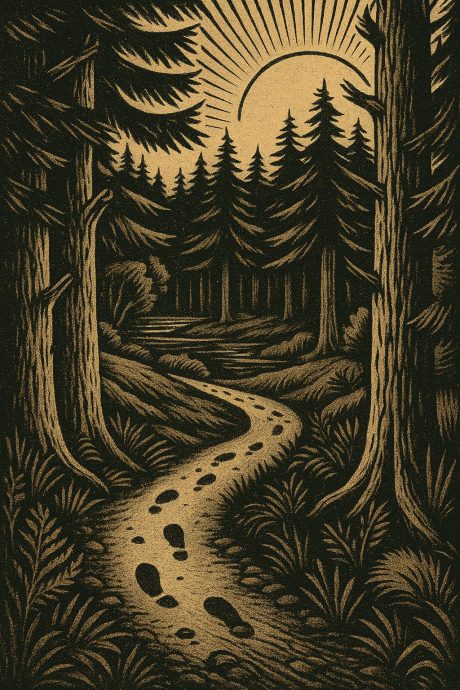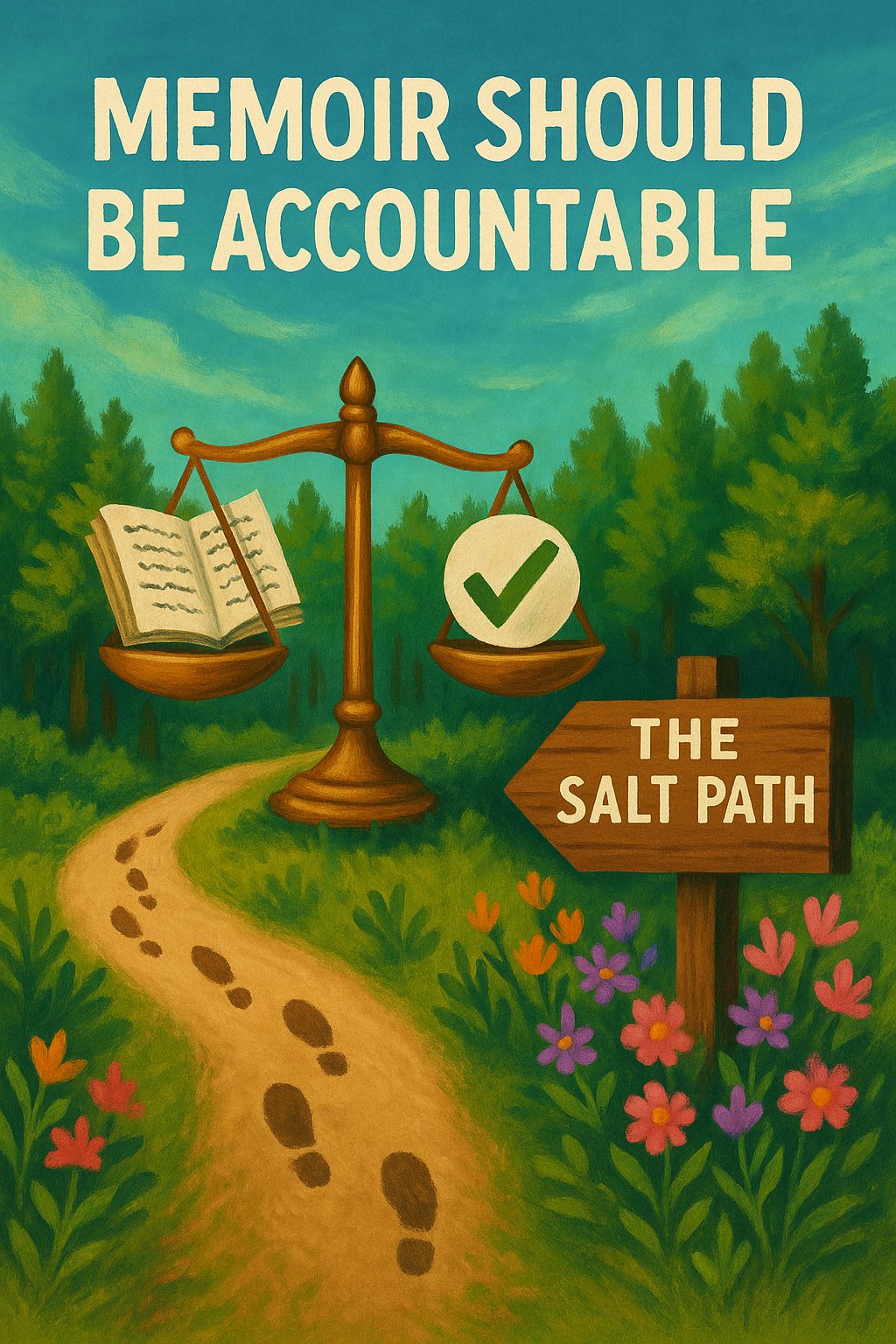
This image of a winding path through dense forest, rendered in a stark linocut style, captures something significant about the memoirist’s journey. The footprints lead into shadow and light, through trees that both shelter and obscure. Like the writing of memory, the way ahead is partial, mysterious, shaped by what we choose to reveal, and what we do not.
The rising sun beyond the trees suggests illumination, but it is distant. As memoirists, we often write towards clarity, but we begin in the woods. Each step marks not only a personal decision, but an ethical one. Who else walks beside us in the story? Who is left in the dark?
This piece follows on from Thirteen Ways of Looking at The Salt Path, where I explored the controversy surrounding Raynor Winn’s bestselling memoir and the difficult questions it raises. I now turn more directly to the broader ethical terrain, reflecting on Winn’s defence of “emotional truth,” and on my own memoir I’m a Teacher, Get Me Out of Here (2004), which I wrote twenty years ago with raw honesty but limited foresight. Time, experience, and my teaching at Goldsmiths have all shifted how I now understand the responsibilities of writing about the self.
What follows is not a set of answers, but a map of the tensions memoirists must navigate. These are Ten Ethical Complexities of Memoir, shaped by The Salt Path, and by the distance I’ve gained from my own.
1. Memoir is not fact, but it must be accountable
Raynor Winn’s The Salt Path offered a story of innocent suffering and stoic resilience. But the Observer’s investigation revealed serious omissions and distortions: a house not simply “taken” by a cruel system, but lost through alleged financial misdeeds; property owned abroad; a trail of unpaid debts (Observer, 2025). Winn has vigorously defended herself, arguing the book reflects her “emotional truth.”
Yet this opens up a necessary question for all memoirists: what is the boundary between storytelling and misrepresentation, especially when sympathy and commercial success are at stake?
2. Memoir always omits—but not all omissions are equal
In my own memoir, I’m a Teacher, Get Me Out of Here (2004), I told the story of a version of myself, a young teacher collapsing under the strain of the English state education system. It was emotionally true, and readers told me it spoke for them. But others, especially former colleagues, felt wounded. I anonymised names, but not always the context. I thought I was telling my story. In hindsight, I was telling theirs too.
As I now teach my students on the MA in Creative Writing and Education at Goldsmiths, memoir is always a relational act: writing about the self is never just about the self.
3. Position matters, especially when you’re in power
I’m a middle-class white man who attended both state and private schools. I attended university on a full grant at a time (1986-89) when higher education was properly funded for students like me, and have had access to publishing, academia, and the platforms that come with them. In today’s Britain, that places me in a position of significant privilege.
But my background is not without rupture. My early life was marked by family breakdown and formative challenges that left deep emotional traces. Later, as a teacher, I encountered pressures and harms—some institutional, some personal—that continue to inform how I think and write.
In my PhD (Gilbert, 2015), I coined the term split positionality to describe this tension: the writer-teacher as both powerful and vulnerable. Many of our students on the MA come with similarly complex positionalities, navigating pain and privilege as they find their voices on the page.
4. Memoir can help the self—but harm others
I’m a Teacher, Get Me Out Of Here (2004) helped me. It let me process trauma, and it made me visible. But it also caused pain. I thought I was being brave. I now see I was also being blinkered. I hadn’t fully reckoned with how my suffering, when given a loud platform, could eclipse the quieter hurts of others.
As I tell our MA students: emotional truth must be tempered with ethical imagination. Sometimes what feels true can still do damage.
5. Emotional truth is powerful—but also seductive
Winn’s memoir, like many bestsellers, follows the arc of fall and redemption. It’s deeply moving. But if the foundations are distorted, narrative power becomes a kind of manipulation. I’m more wary of this now, and I ask students to interrogate the structures their stories rely on: victimhood, resilience, forgiveness. Who benefits? Who disappears?
6. Fiction can deepen truth—but must be signposted
In my PhD, I explored the boundary between fiction and memoir, drawing on Suzanne Nalbantian’s idea of aesthetic autobiography: the use of fictional strategies to evoke emotional truth (Nalbantian, 1997). This remains a powerful tool, and many of our MA students use it—but it must be done transparently.
At Goldsmiths, we require ethical review for memoir writing that involves real people. Fictionalisation becomes not just an aesthetic choice, but an ethical practice.
7. Memoir is written in time, and time changes us
When I wrote in 2004, teaching memoirs were rare. Now they are common. I’ve changed too. My story is still read but I often wince when I see my younger self speaking through those pages. In class, we talk about this: how narrative fixes a version of the self that might no longer feel right.
Memoir is fossil and echo. It requires periodic reckoning.
8. Privilege doesn’t cancel pain, but it reshapes it
This is the hardest truth. I’ve suffered. But my suffering has never removed my structural power. I’ve had access to therapy, platforms, publication. Others haven’t. On our MA, we try to hold these truths together: trauma doesn’t justify unethical storytelling. Positionality doesn’t erase pain, but it must be acknowledged.
9. Memoir is love, but love needs ethics
Memoir can be an act of self-love, reclaiming the wounded self, forgiving the ashamed one. But if love doesn’t extend outward, it becomes indulgence. I often ask our MA cohort: “Who else is in this story, and do they feel loved?” That question reshapes the writing.
10. The truth evolves. Memoir must too.
The 2004 me is still out there, still speaking in print. But I’m no longer him. That’s both beautiful and complicated. Winn may now be discovering the cost of that distance.
As I wrote in my PhD: “Narrative fixes what time would dissolve. But it also obscures what time reveals.” (Gilbert, 2015: 89)
In our MA programme, we teach students to embrace that fluidity, to write as process—not proclamation. To see memoir not as monument, but as conversation.
Conclusion
Memoir remains one of the most powerful forms of writing we have. But it is not innocent. It asks us to be brave but also kind. Transparent, but also tactful. Reflexive, not reactive.
These are the questions we ask in the MA in Creative Writing and Education at Goldsmiths. If you are writing your own story—or helping others to write theirs—we invite you to join us.

Further Reading
Gilbert, F. (2015) Who Do You Love? The Novel of my Life (Creative Writing thesis) and Building Beauty: the Role of Aesthetic Education in my Teaching and Writing Lives (commentary on the Creative Writing thesis) URL: https://research.gold.ac.uk/id/eprint/14858/ (Accessed 9/7/2025)
Hirsch, M. (2012) The Generation of Postmemory: Writing and Visual Culture After the Holocaust. Columbia University Press.
Nalbantian, S. (1994) Aesthetic Autobiography: From Life to Art in Marcel Proust, James Joyce, Virginia Woolf and Anaïs Nin. London: Macmillan.
Smith, S. and Watson, J. (2010) Reading Autobiography: A Guide for Interpreting Life Narratives. Minneapolis: University of Minnesota Press.


Leave a Reply